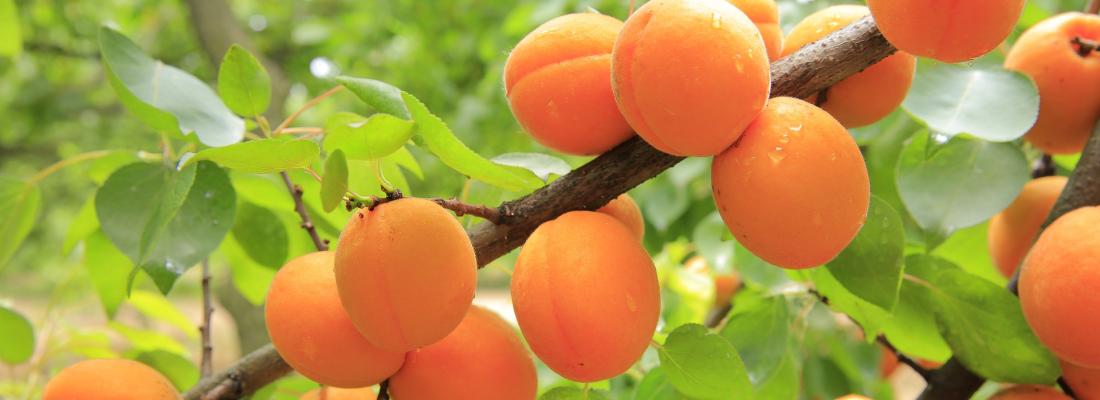Biodiversity Reading time 3 min
Domestication history of apricots retraced through genomics
Published on 30 June 2021

Over the course of the domestication of fruit trees, human selection has affected reproductive and vegetative traits (such as the flowering period), fruit features (for example size, acidity, firmness and flavour), as well as crop response to biotic stress (e.g. bacteria and pests) and abiotic stress (e.g. drought and cold weather). Human selection, being recent and strong, has left footprints in genomes that are easier to detect than those typically left by natural selection.
Apricots are good models for identifying the genes that have been under selection during domestication and for studying the adaptation processes of fruit trees. Indeed, apricots have a small genome (~220 Mb[1], i.e. less than twice that of thale cress, Arabidopsis thaliana, and 70 times smaller than that of wheat), and wild populations that share a common ancestor with cultivated apricots are available. To reconstruct the history of their domestication, INRAE, the universities of Bordeaux and Paris-Saclay, and the CNRS assembled four high-quality genomes[2] from the domesticated species and its relatives and analysed the sequences of more than 900 accessions[3]originating from different geographic locations throughout the world.
Different domestication events
Prunus armeniaca L. refers to both the wild ancestor of apricots and the common cultivated species. Its natural populations still only occur in central Asia[4]. In addition to cultivated and wild apricots, the researchers also studied four other related Armeniaca species: three endemic to East Asia[5], principally China, and one present in the French and Italian Alps[6].
The study shows that European and Chinese cultivated apricots form two distinct genetic groups that resulted from independent domestication events. Long considered native to China, apricots cultivated in Europe actually come from a wild population from northern central Asia, while apricots cultivated in China were domesticated from a population in southern central Asia. Apricots grown in Europe and China have similar traits (shape and fruit size, tree phenology, etc.), which suggests a converging adaptation over the course of parallel domestication events. This raises the question: does such convergent adaptation occur through similar changes in the same genomic regions?
Different regions of the genome impacted
Despite their similarities, human selection targeted different regions of the genome in European versus Chinese cultivated apricots. This means that different genomic modifications can lead to the same adaptive phenotypes. In both groups, the genes affected by human domestication had predicted functions involved in the perennial life cycle, fruit quality and disease resistance. The large size of apricot populations, the long life cycle[7] of perennial cultures, and the subsequent gene flow observed between wild and cultivated populations have allowed domesticated apricots to maintain high genetic diversity and led to relatively low proportions of the genome being affected by selection (0.42% and 0.22% in European and Chinese apricots, respectively).
Compared with annual crops such as maize and rice, the footprints of adaptive events in fruit tree genomes, in response to domestication, are the subject of few studies and poorly understood. The results of this study will help advance knowledge of adaptation processes. Identifying the genomic regions impacted by human selection further provides clues to the biology of selected traits during domestication and targets for fruit tree research and breeding.
[1] Millions of base pairs
[2] High-quality genome assemblies consist in assembling sequence reads (long and short fragments) with optical maps into longer sequences (contigs or pseudomolecules) in order to obtain one single sequence for each individual chromosome.
[3] Accessions: Individuals from samples of vegetatively propagated material, taken at the same time from the same place. There is only one way to identify accessions and each accession represents a sample from a parent tree collected in situ, a cultivar, a lineage or a population.
[4] Liu et al., 2019 (DOI: 10.1111/mec.15296); Decroocq et al., 2016 (DOI: 10.1111/mec.13772)
[5] P. mume, P. sibirica L., P. mandshurica
|
Reference Groppi, A., Liu, S., Cornille, A. et al. Population genomics of apricots unravels domestication history and adaptive events. Nat Commun 12, 3956 (2021). DOI: 10.1038/s41467-021-24283-6 |
